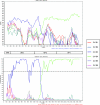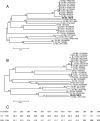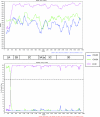Natural recombination event within the capsid genomic region leading to a chimeric strain of human enterovirus B
- PMID: 17537864
- PMCID: PMC1951430
- DOI: 10.1128/JVI.00180-07
Natural recombination event within the capsid genomic region leading to a chimeric strain of human enterovirus B
Abstract
Recombination between two strains is a known phenomenon for enteroviruses replicating within a single cell. We describe a recombinant strain recovered from human stools, typed as coxsackievirus B4 (CV-B4) and CV-B3 after partial sequencing of the VP1 and VP2 coding regions, respectively. The strain was neutralized by a polyclonal CV-B3-specific antiserum but not by a CV-B4-specific antiserum. The nucleotide sequence analysis of the whole structural genomic region showed the occurrence of a recombination event at position 1950 within the VP3 capsid gene, in a region coding for the 2b antigenic site previously described for CV-B3. This observation evidences for the first time the occurrence of an interserotypic recombination within the VP2-VP3-VP1 capsid region between two nonpoliovirus enterovirus strains. The neutralization pattern suggests that the major antigenic site is located within the VP2 protein.
Figures






Similar articles
-
Molecular epidemiology of coxsackievirus B4 and disclosure of the correct VP1/2A(pro) cleavage site: evidence for high genomic diversity and long-term endemicity of distinct genotypes.J Gen Virol. 2000 Mar;81(Pt 3):803-12. doi: 10.1099/0022-1317-81-3-803. J Gen Virol. 2000. PMID: 10675418
-
Evolution of the genome of Human enterovirus B: incongruence between phylogenies of the VP1 and 3CD regions indicates frequent recombination within the species.J Gen Virol. 2003 May;84(Pt 5):1223-1235. doi: 10.1099/vir.0.18971-0. J Gen Virol. 2003. PMID: 12692288
-
Genomic characterization of coxsackievirus type B3 strains associated with acute flaccid paralysis in south-western India.J Gen Virol. 2016 Mar;97(3):694-705. doi: 10.1099/jgv.0.000391. Epub 2016 Jan 7. J Gen Virol. 2016. PMID: 26743460
-
Comparative genomics of the coxsackie B viruses and related enteroviruses.Curr Top Microbiol Immunol. 2008;323:33-47. doi: 10.1007/978-3-540-75546-3_2. Curr Top Microbiol Immunol. 2008. PMID: 18357764 Review.
-
Coxsackievirus B5 and the relationship to swine vesicular disease virus.Curr Top Microbiol Immunol. 1997;223:153-67. doi: 10.1007/978-3-642-60687-8_7. Curr Top Microbiol Immunol. 1997. PMID: 9294928 Review. No abstract available.
Cited by
-
Genetic relationship between cocirculating Human enteroviruses species C.PLoS One. 2011;6(9):e24823. doi: 10.1371/journal.pone.0024823. Epub 2011 Sep 12. PLoS One. 2011. PMID: 21931857 Free PMC article.
-
Study of Coxsackie B viruses interactions with Coxsackie Adenovirus receptor and Decay-Accelerating Factor using Human CaCo-2 cell line.J Biomed Sci. 2014 May 21;21(1):50. doi: 10.1186/1423-0127-21-50. J Biomed Sci. 2014. PMID: 24885774 Free PMC article.
-
Genetic characterization and molecular epidemiology of Coxsackievirus A12 from mainland China during 2010-2019.Front Microbiol. 2022 Dec 21;13:988538. doi: 10.3389/fmicb.2022.988538. eCollection 2022. Front Microbiol. 2022. PMID: 36620057 Free PMC article.
-
Recombination in Enteroviruses, a Multi-Step Modular Evolutionary Process.Viruses. 2019 Sep 14;11(9):859. doi: 10.3390/v11090859. Viruses. 2019. PMID: 31540135 Free PMC article. Review.
-
Etiologies of Acute Bronchiolitis in Children at Risk for Asthma, with Emphasis on the Human Rhinovirus Genotyping Protocol.J Clin Med. 2023 Jun 8;12(12):3909. doi: 10.3390/jcm12123909. J Clin Med. 2023. PMID: 37373604 Free PMC article.
References
-
- Altschul, S. F., W. Gish, W. Miller, E. W. Myers, and D. J. Lipman. 1990. Basic local alignment search tool. J. Mol. Biol. 215:403-410. - PubMed
-
- Andersson, P., K. Edman, and A. M. Lindberg. 2002. Molecular analysis of the echovirus 18 prototype. Evidence of interserotypic recombination with echovirus 9. Virus Res. 85:71-83. - PubMed
-
- Auvinen, P., M. J. Makela, M. Roivainen, M. Kallajoki, R. Vainionpaa, and T. Hyypia. 1993. Mapping of antigenic sites of coxsackievirus B3 by synthetic peptides. APMIS 101:517-528. - PubMed
-
- Beatrice, S. T., M. G. Katze, B. A. Zajac, and R. L. Crowell. 1980. Induction of neutralizing antibodies by the coxsackievirus B3 virion polypeptide, VP2. Virology 104:426-438. - PubMed
-
- Blomqvist, S., A. L. Bruu, M. Stenvik, and T. Hovi. 2003. Characterization of a recombinant type 3/type 2 poliovirus isolated from a healthy vaccinee and containing a chimeric capsid protein VP1. J. Gen. Virol. 84:573-580. - PubMed
Publication types
MeSH terms
Substances
Associated data
- Actions
LinkOut - more resources
Full Text Sources

